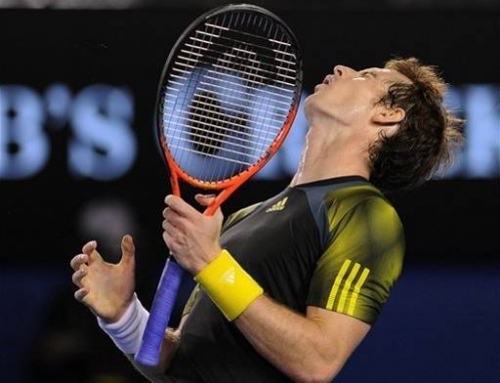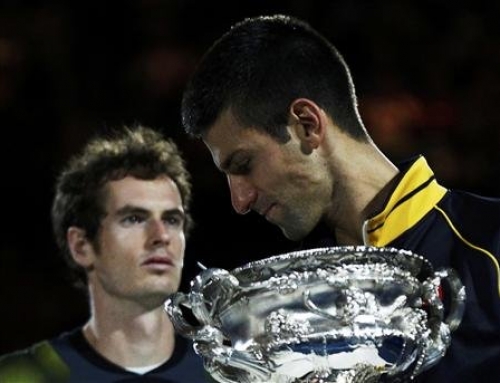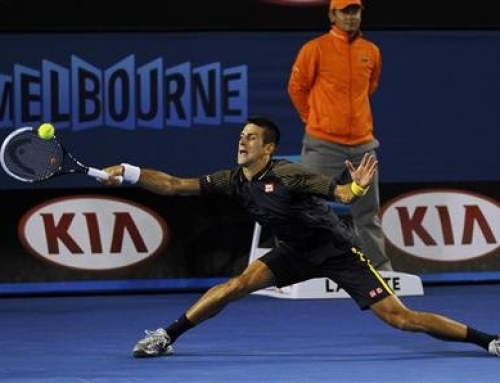 Looking through the draw of any Slam, you’re likely to notice a lot of Spaniards. And a lot of Frenchman. Who knew the Pyrenees would divide two prolific tennis playing countries? You wouldn’t see a lot of Americans, certainly, not many top 50 Americans, and it might lead you to ask “What happened to all the Americans”? They never seem to ask this of the Swiss. What happened to all the Swiss? The Swiss have had their occasional good player. Jakob Hlasek, here, Heinz Gundhardt there, and a Marc Rosset, for good measure. And then, they get an exceptional player like Roger Federer, which is maybe bonus for being a small country that prides itself in chocolate and neutrality and a bit of skiing.
Looking through the draw of any Slam, you’re likely to notice a lot of Spaniards. And a lot of Frenchman. Who knew the Pyrenees would divide two prolific tennis playing countries? You wouldn’t see a lot of Americans, certainly, not many top 50 Americans, and it might lead you to ask “What happened to all the Americans”? They never seem to ask this of the Swiss. What happened to all the Swiss? The Swiss have had their occasional good player. Jakob Hlasek, here, Heinz Gundhardt there, and a Marc Rosset, for good measure. And then, they get an exceptional player like Roger Federer, which is maybe bonus for being a small country that prides itself in chocolate and neutrality and a bit of skiing.
They asked this question in the mid 1980s. McEnroe had just lost a final to Ivan Lendl in the 1985 US Open, and much like Borg did in 1981 when he lost the US Open to McEnroe, Johnny Mac took a break. While he would show flashes of brilliance, and nearly contend for Slams, he would never win another Slam, never even reach another final. Connors, a few years older, was mostly past his prime in the mid 1980s. Again, much like John McEnroe, he would reach a semifinal of a Slam here and there, most notably in 1991 in his one last hurrah, but never reach another final.
Then came the gold mine. It started with 3 players in 3 different ways. In 1989, 17 year old Michael Chang would come out of nowhere, upset Ivan Lendl in the fourth round, and beat Stefan Edberg in five sets in the finals, the only Slam that Edberg never won, and the only time he ever reached the final. Chang had accomplished something no American had accomplished since 1955–win the French Open. Few knew that Americans would win their share of French Opens after that.
It really started with Andre Agassi in 1987 who made a huge splash in an event held in Stratton, Vermont, called the Volvo International. In the semifinals, with his over-the-top haircut, and a forehand that looked bigger than Lendl’s, Agassi served notice that there was American talent on the horizon. He pushed Lendl to three sets, losing 6-2, 5-7, 6-3. By the US Open, Agassi was already the fourth seed, and reached the semifinals, true to his seed, where he lost to Lendl in four sets. In 1988, Agassi would reach the French Open semifinals and lose in five sets to eventual winner, Mats Wilander. In 1990, he’d reach his first French Open final, losing to veteran Ecuadorean, Andres Gomez, in 4 sets. Later that year, he’d reach his first US Open final, and lost to the third member of the early triumvirate, Pete Sampras. In 1991, Agassi would again reach the French Open finals, but this time lose to Jim Courier, and he becomes the fourth American to break through.
Beyond Sampras, Courier, Agassi, and Chang, there were plenty of less successful Americans, either members of the Bollettieri Academy or folks that competed against them. These include Todd Martin, MaliVai Washington, David Wheaton. Martin and Washington actually took the old-fashioned route and played college tennis.
Once Sampras retired, after his US Open victory in 2002, there were again worries that American tennis had no successors. For as wildly successful as the Americans were through the 1990s, there wasn’t a huge crop of Americans that followed in their footsteps. The most prominent of the Americans was Andy Roddick.
Andy Roddick not only had a huge, huge serve, but he had a huge forehand. And he even looked the part. If there was a male equivalent to Anna Kournikova–and there really wasn’t, the closest would be Andy Roddick, except Roddick knew how to win. In 2003, Roddick won his first US Open, and it seemed his future knew no limits. Roddick helped popularize the then-unknown Babolat racquet. Plenty of teens and pre-teens, and let’s face it, middle-aged men with income, bought the black and teal racquet hoping to get a few more mph’s on their serve.
Two years later, in 2005, American Express made commercials featuring Andy Roddick who was looking for his “mojo”. Apparently, he lost it because he promptly lost to Gilles Muller in three tiebreak sets. This loss, perhaps more than any other, may have shown that Roddick was not ready to take the mantle from Agassi or Sampras. Well, that and Roger Federer. And Lleyton Hewitt. And Rafael Nadal. And Novak Djokovic.
Andy Roddick had the misfortune of playing with a player many acknowledge to be the GOAT. While Roger Federer piled on the Grand Slam hardware and left little for anyone else, players like Roddick merely hoped to get into finals of Slams and get a chance here or there to maybe sneak a Slam title, at least one more time. In the meanwhile, rather than cry about his situation, he made changes to his game to try and retool. In particular, that fearsome forehand that was the staple of his game disappeared. Replacing that was a steadier Roddick that won matches in a less flashy way. His big serve was no longer producing a flurry of aces, but was still formidable enough to let him hold serve most of the times against most players he played.
And this kept him in the top 10 for many years.
But who was next? There were contemporaries of Roddick who bloomed late, players like James Blake and Mardy Fish, but they never reached Roddick’s level.
Perhaps the name that many had hoped would be contending for titles was the lefty, Donald Young. Once the number 1 junior in the world, Young’s future seemed bright. But after a series of wildcards over several years, Young never cracked the top 50. Players that were his rivals, most notably, Sam Querrey, were playing better and having better results. The new face of American tennis appeared to be big-man tennis.
Querrey, at 6 feet 6, joined the tour in 2006, but didn’t make a huge splash until he won a tournament in Las Vegas in 2008. He’d reached the semis of Delray Beach a few weeks earlier losing to Kei Nishikori (who would win the tournament over James Blake). Querrey continued to play well, but didn’t win again until the following year. 2009 was a good year for Querrey.
He started with a run to the finals in Auckland where he lost to Juan Martin del Potro (who failed to defend his title, so slipped back to number 5 in the world on the first Monday of the 2010 Australian Open). He would next reach a final in Newport, losing to fellow American, Rajeev Ram. Querrey was a bit lucky. He had planned to play all the tournaments leading up to the US Open in the “US Open Series”. Normally, Davis Cup follows Wimbledon and Querrey was good enough to be called to play, but they had asked Mardy Fish and James Blake to play (Andy Roddick had begged out due to injuries sustained at Wimbledon).
Querrey then went to Indianapolis where he again reached the final, this time to Robby Ginepri. Ginepri’s titles have only ever come at Indianapolis (this was his 2nd title ever). Some thought Ginepri might be the next American hope, but recently, Ginepri has come to the conclusion that his best years were behind him, that he may have peaked at the US Open when he reached the semifinals, and he’ll never reach those heights again.
Querrey finally won Los Angeles where he beat Aussie, Carsten Ball. Later, he would reach the final of New Haven, losing to Fernando Verdasco. At the US Open, he lost in the 3rd round to Robin Soderling. Although the US Open result wasn’t as good as hoped, Querrey’s summer was very successful.
Querrey would then head to Bangkok after the US Open. He would get into a freak accident, cutting his arm while sitting on a glass table, nearly severing a never. Querrey would sit out the rest of the year.
In the meanwhile, another tall player, who took a different route to success, John Isner was starting to improve his game. In particular, he would upset Andy Roddick in the third round. Roddick, himself, would say that he felt much better playing in the 2009 US Open than he did in 2008, even though his 2008 results were better. It’s just how things worked out. Isner would lose in the next round to Fernando Verdasco, yes, the same one that knocked out Querrey the week before the US Open.
Isner would set two goals for himself in 2010. He wanted to win a tournament. He head already reached the finals of Washington DC in 2007 when Fernando Gonzalez dropped out and opened up a spot for him. He’d lose to in a close match to Andy Roddick in the finals.
Isner finally won his first tournament in Auckland (which Juan Martin del Potro won the previous year over Sam Querrey) beating Arnaud Clement. He went into the Australian Open feeling pretty good about his game, and indeed, with that win, Isner moved one spot ahead of Sam Querrey with a ranking of 28 (Querrey at 29). Admittedly, he wasn’t able to take advantage of this ranking for seeding purposes, but was the lucky recipient of the 33rd seed when Gilles Simon withdrew due to injury.
And now, the quite giant, John Isner, finds himself in the fourth round facing Andy Murray, beating a player that most would say is the most athletic player playing, Gael Monfils. Of all the top seeds Isner could have played, Monfils might have been the one he’d pick (or Andy Roddick), because he had had a 2-1 record over him.
Neither John Isner nor Sam Querrey look like the kind of player that will take Andy Roddick’s place in the top 10. As big men, they are still working on their speed and their footwork, trying to find ways to augment their big serves and their big forehands. Even so, they’ve made advances in their career, and so while Americans once had plenty of great players, this is a time where we can be proud of players that may not have the same kind of wild talent of the 1990s, but are proving successful in their own way.






![[Aussie Open Final] Can Andy Murray beat Novak Djokovic?](https://www.essentialtennis.com/wp-content/uploads/2013/01/20130126andy-500x383.jpg)
![[Day 13, Aussie Open] Bryan brothers win 13th Slam with Aussie doubles title, Kyrgios wins boys title](https://www.essentialtennis.com/wp-content/uploads/2013/01/20130125bryan-500x383.jpg)